Soundproofing a garage involves using acoustic foam, curtains, blankets, carpets, and decoupling to reduce the amount of noise that gets in and out.
Have you tried to play musical instruments in your garage and ended up angering your neighbors? Are you trying to block out noise from outside coming in?
Combining different methods of soundproofing is what works best. Most people go all in on one, which doesn’t give them the desired results.
We’ve got a full guide for you to soundproof your garage for band practice and workshops.
How to Soundproof a Garage: 7 Different Methods
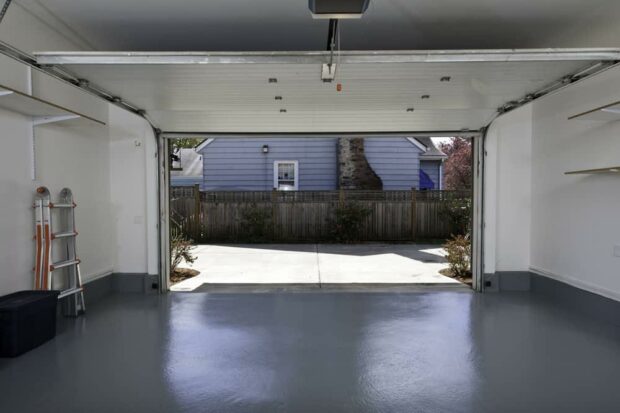
Soundproofing a garage is one of the most important things you can do if you’re planning to turn it into a recording studio or just want to use your garage for band practice.
There are 7 different ways to soundproof a garage, and you can use either one or all of these methods combined based on your budget and how soundproof you want it to be.
You can create a garage that can both block sound going out and outside noise coming in!
1. Soundproof a Garage Door
The garage door can often be the most problematic part of the entire garage to soundproof because it’s the only part of the garage that has many moving parts.
Here are a few ways you can soundproof a garage door.
Acoustic Blankets
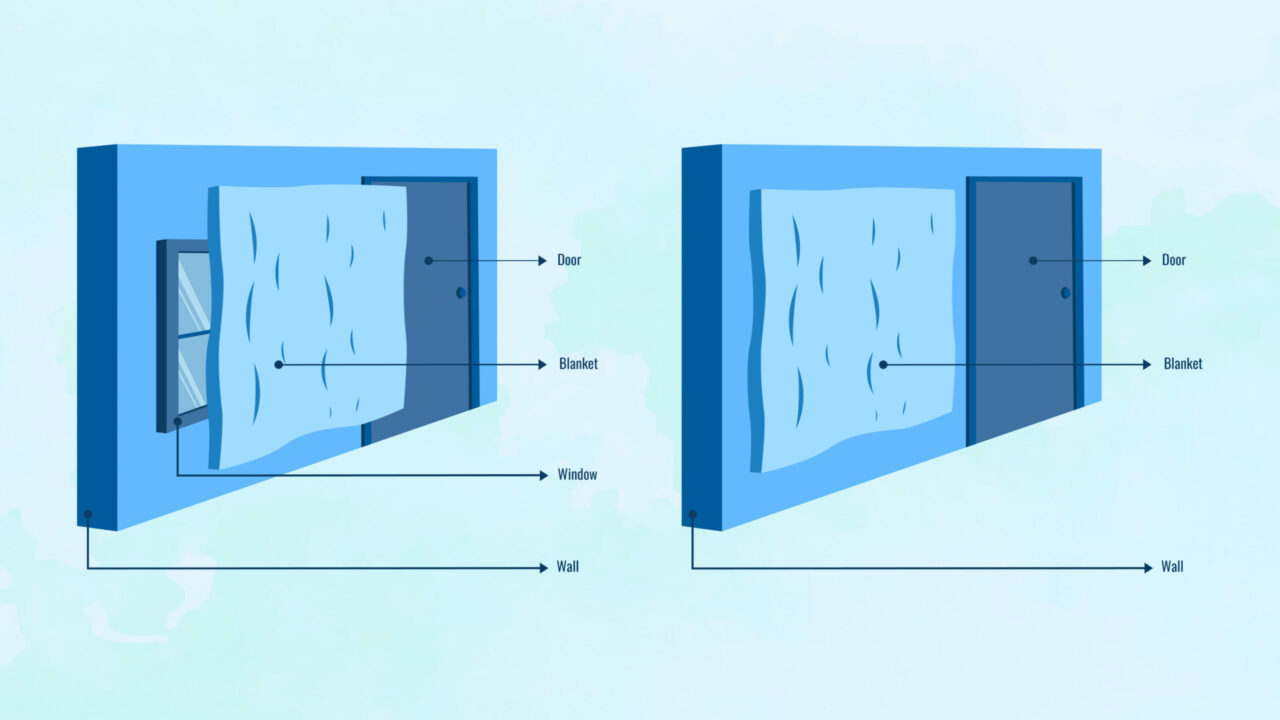
The best solution to soundproof a garage door is to hang noise-blocking curtains or acoustic blankets to stop noise transmission from leaking outside of the garage.
Acoustic blankets use fiberglass panels or polyvinyl chloride materials that have sound-absorbing properties and are commonly used for doors and other movable parts.
One issue you may encounter when using acoustic blankets is that they’re LARGE. This means you’d need to put some effort and time into cutting them into the shape of your garage doors.
An alternative option would be to use moving blankets made of wool. They’re lighter and cheaper than acoustic ones, meaning mistakes in cutting them won’t be as costly.
Insulated Doors
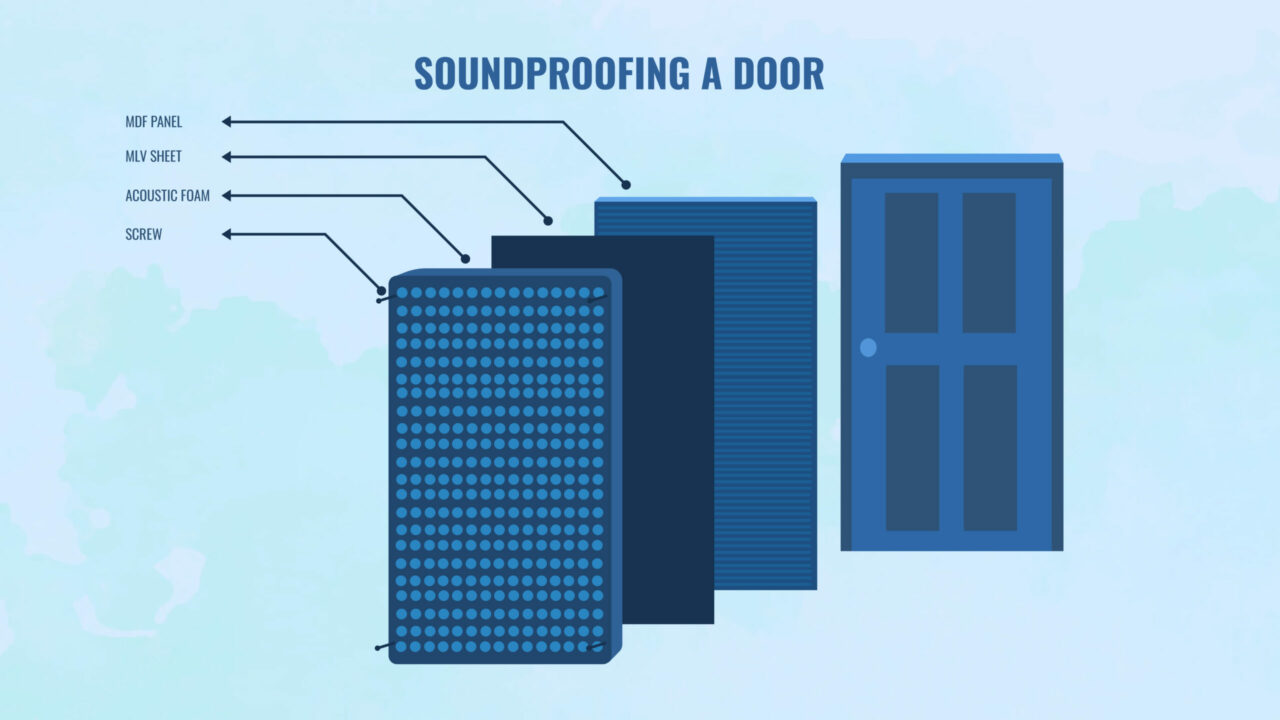
Depending on how your garage door was made, it will be either insulated or non-insulated. The former is more soundproof because it has more absorbent materials inside.
Non-insulated doors are more hollow, meaning that sound waves that get through the first layer of materials on the garage door don’t encounter any resistance.
This leads to the sound waves passing easily through the garage door.
If your garage door isn’t properly soundproof already, you should consider spending a bit more to do so.
Not only will it help with sound absorbing sound waves, but it will also keep temperatures at warmer levels during cold seasons!
2. Soundproofing Garage Walls and Ceilings
Garage walls and the garage ceiling are two of the next most important parts of the garage that you should consider in your soundproofing project.
Sound waves can easily bounce off the garage walls or garage ceiling because the materials used to create them are usually hard and reflective.
These properties are not ideal if you want to prevent sound waves from bouncing around and creating echoes in your recording studio.
While you can use the same acoustic sheets or soundproof curtains mentioned earlier to prevent sound leakage, another option might fit better.
Soundproofing Tiles and Acoustic Foam Panels
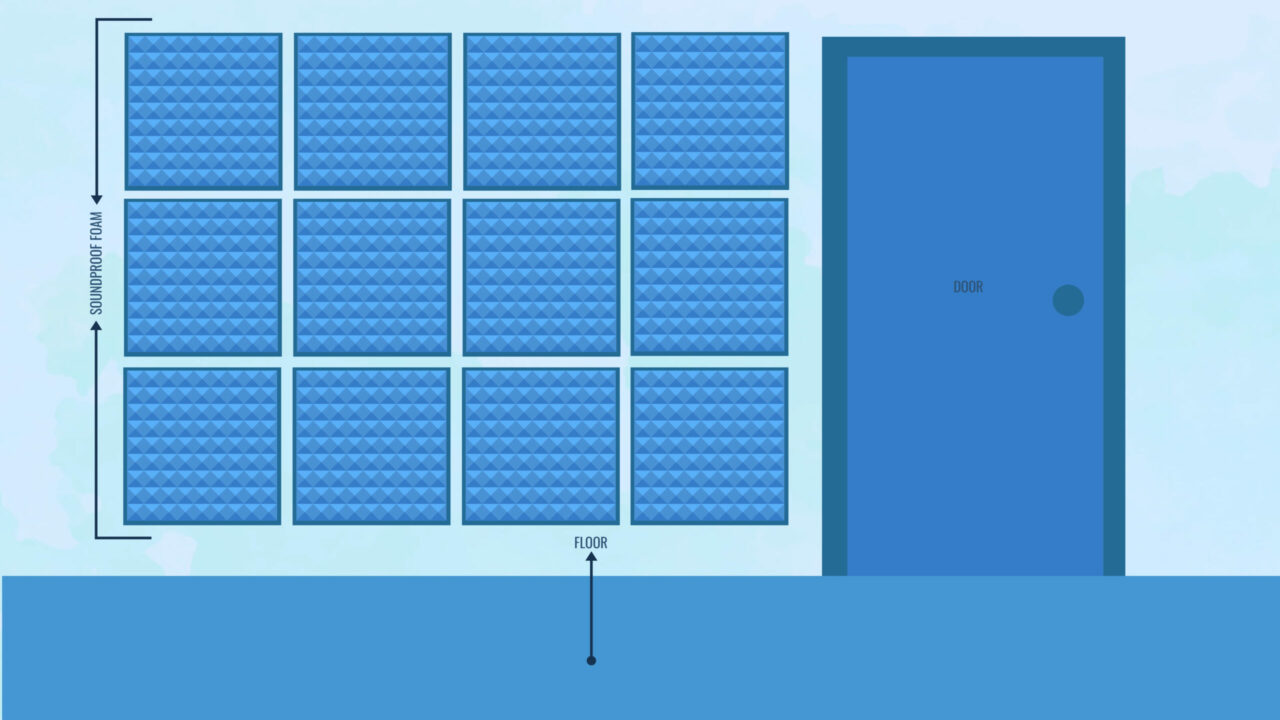
Acoustic foam panels and soundproofing tiles are made of soundproofing materials designed to prevent any sound waves from bouncing around.
They’re cut into tiles with triangle patterns or pyramid and wedge shapes. These panels will absorb sound waves instead of allowing them to be reflected off flat surfaces.
They’re somehow the cheaper solution compared to acoustic blankets while looking more aesthetic and completing that signature look most recording studios have.
Another thing that makes them the better option is that you can install acoustic foam panels by sticking them onto walls and the ceiling instead of having them hang there.
QUICK TIP
There are many creative designs available if you’re thinking of adding acoustic foam panels to your garage soundproofing. You’ll improve both sound quality and how your garage looks!
Soundproofing Inside Ceiling Joists
Garage ceiling soundproofing can be done easily if you have ceiling joists. Insert insulated pads or mats in between the joists and wall assembly to absorb sound.
This is a cost-effective and easy way to install soundproofing because of the toolless installation and easy assembly/disassembly.
3. Soundproofing Your Garage Windows
One of the biggest sources of sound waves leaking from a room inside to outside is through windows, especially glass windows. Glass isn’t a good material for blocking noise.
Windows also often have gaps between the glass pane and the window cutout. These gaps aren’t blocking sound at all, just letting sound pass through.
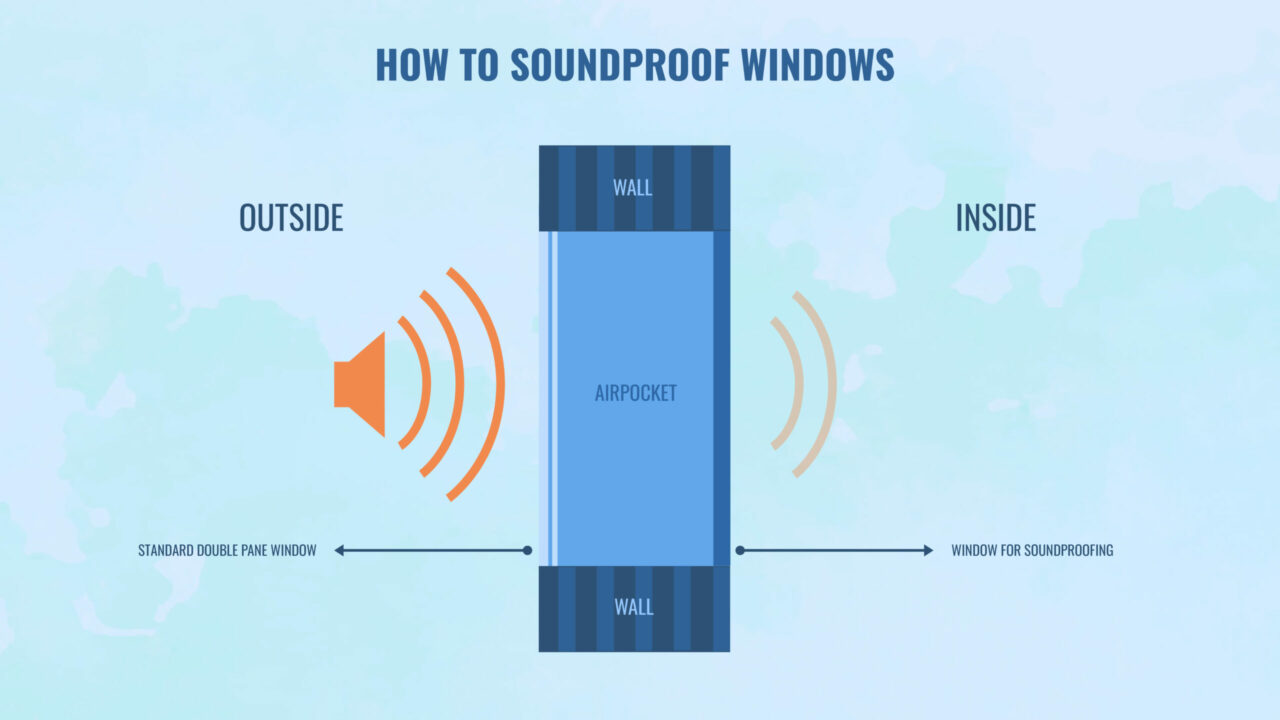
Seal Windows and Doors
The first thing you’ll want to do is use acoustic sealants or adhesive to create a window and door seal.
This means covering all openings and gaps between the windows and doors in the room.
Doing this will make sure that no sound can easily pass through small openings and has to contact other surfaces like the soundproofing material you’ve installed on the walls.
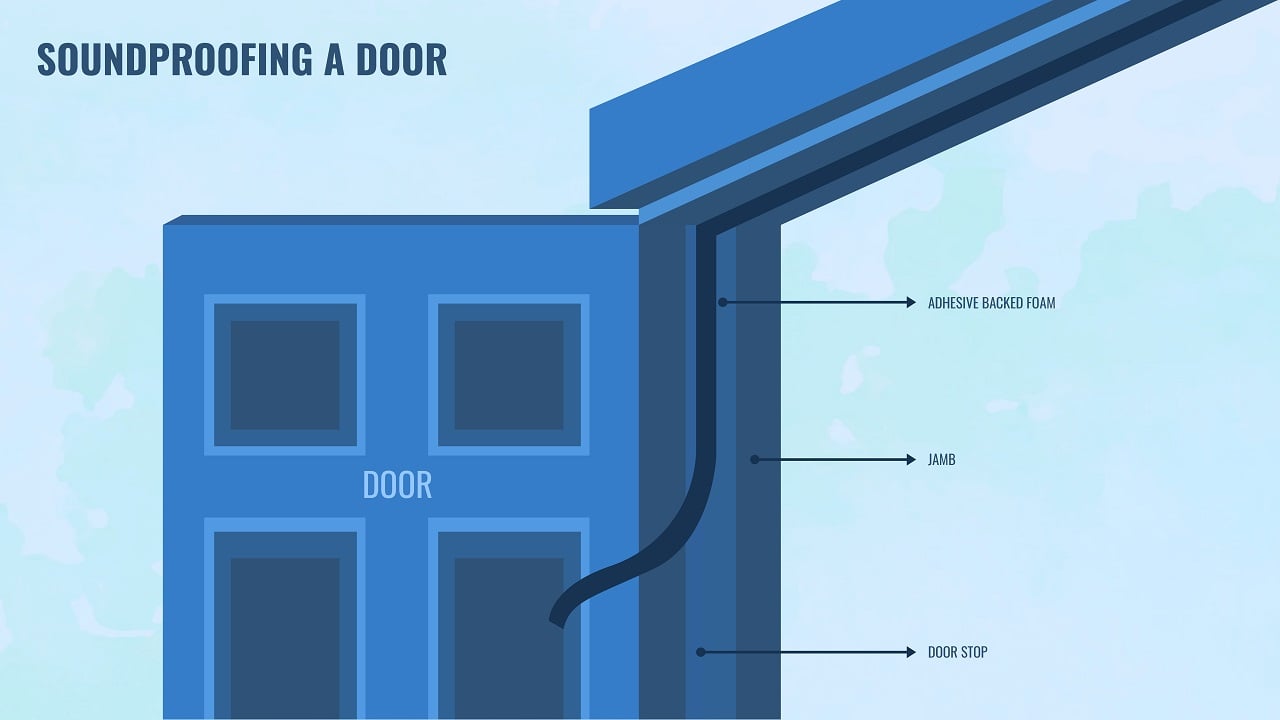
PRO TIP
If you can’t find any acoustic sealant, get weather-proof stripping from your local hardware store. They block sound to a similar level and are widely available.
Noise Blocking Curtains
Similarly to how you’d do it for garage doors, you can hang noise-blocking curtains over the windows in your garage.
This extra layer of fabric between the glass window pane and the sound coming from the instruments will help block noise from getting out.
It’s more convenient than completely blocking off the window because you can easily remove the curtains after you’re done recording or practicing with your musical instrument.
4. Soundproofing the Garage Floor
Like other areas within the garage, the garage floor wasn’t designed with sound quality inside in mind.
However, the garage floor is probably the easiest part of the room to work with when trying to make your garage soundproof, because of the simple and easy-to-find solution.
Install a Carpet
All you really need is a carpet. Garage floors, like any other type of floor, have flat and reflective materials.
This makes them reflective to sound waves which can change how recordings sound. Floor-mounted instruments like drums can also sound different with varying floor materials.
Carpets are made with material that absorbs sound. They’re also easy to find as they’re available in most department and home furniture stores.
FUN FACT
You’ll see many popular musicians playing and recording barefoot – because they’re playing and recording on a soft carpet!
5. Soundproof Your Garage for Band Practice
When you soundproof a garage for band practice, there are different musical instruments to keep in mind. Different instruments play at varying sound levels and frequencies.
Electric guitars, when hooked up to an amp, can produce up to 115 dB of sound and have mostly midrange frequencies.
Drums, on the other hand, can produce from 90 dB up to 130 dB of sound on their own.
They’re harder to block sound for because they produce both low frequencies (bass drums) and high frequencies (cymbals).
DID YOU KNOW
Low frequencies are harder to block because their sound waves tend to penetrate rather than reflect or get absorbed by walls.
To combat this, you should consider installing acoustic foam panels and thick floor coverings in your garage.
6. Soundproof a Garage for a Workshop
People need a soundproof garage for different reasons. Another common reason is using it as a garage workshop. Unfortunately, noisy power tools can bother the neighbors.
A hand drill can reach up to 98 decibels (dB) of noise, while a circular saw can reach up to 118 dB. Workshop tools are no slouch in producing loud sounds.
Continuous use of these power tools can actually damage your hearing because of the high decibels you’re exposed to. Therefore, there are a few things you should do.
Wear Ear Protection
When using power tools, it’s recommended to wear ear protection like ear plugs or safety earmuffs to deaden the sounds coming in.
If you don’t do this and continue to expose your ears to louder sounds, you might develop hearing issues like tinnitus, which is a constant ringing noise in your ear.
Build a Room Inside a Room
While this sounds costly at first, it’s actually cheaper than trying to soundproof your garage as a whole.
Build a room inside a room with insulation, acoustic panels, and a carpet. Swap that last addition if you work with wood, as the shavings might get stuck inside the carpet hairs.
You can make it as small or big as you want, depending on the space you need for your tools and items you’re working on to fit in.
This is often cheaper than soundproofing a garage as a whole because you can splurge on more soundproof panels or add mass loaded vinyl in a smaller space.
Another advantage of doing this for your garage workshop is that the rest of your garage can be used for other purposes!
7. Decoupling
Decoupling is creating a smaller room inside the garage. What this does is create a sound barrier between the walls so that sound waves have to pass through more material and space.
There are methods like creating resilient channels to achieve this. The only part they don’t separate is the garage floors because you’d be standing on it.
Resilient Channel
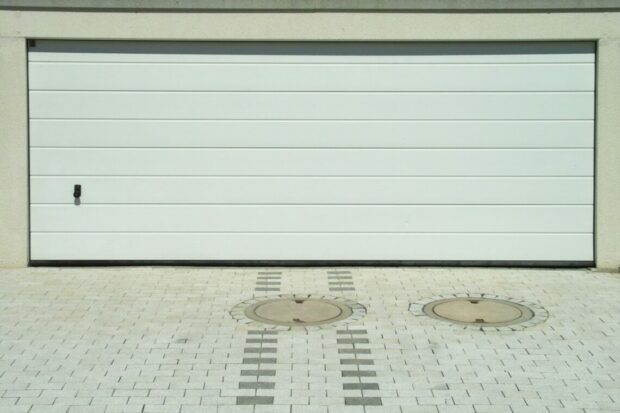
Although a resilient channel is more expensive than some other methods, it’s more effective and cheaper than covering the walls in mass loaded vinyl.
The resilient channels fit directly onto the walls and ceiling to isolation clips. They then connect to drywall boards that simulate another wall.
These act as a sound barrier that adds an additional layer of materials for noise to pass through before it gets in or out.
If you want a more professional and single solution to soundproof your garage, then installing resilient channels is one of the most effective ways to do so.
Why Should I Soundproof My Garage? [3 Benefits]
There are two things most people want to do when trying to soundproof a garage: reduce noise transmission going out or reduce it coming in.
However, some people choose to watch movies or record music in their garage. This means they’d also want to improve the sound quality within the garage.
One thing is clear: overall noise reduction improves experiences for everyone, whether inside the garage or outside!
1. Noise Reduction Going Out
This is the most common reason why people want to soundproof a garage. They don’t want to disturb their neighbors or even family members in other rooms in the main house.
Some sounds you’d want to isolate inside your soundproof garage include:
- Large stereos or garage TVs
- Woodworking
- Power tools and propulsion transmission noise
- Garage band practice
While you might love doing these activities or need to do them, people around you don’t like the airborne noise they create.
2. Noise Reduction Going In
Sometimes, you’d like to keep the noise from outside from going in so that it doesn’t distract you from your work. Garage soundproofing allows you to do this.
Making a soundproof garage will help you reduce these noises from bothering you:
- Loud children playing outdoors
- Cars and trucks driving past your house
- Fireworks
- Dogs barking
- The neighbor mowing their lawn
These annoying and distracting sounds can be reduced or blocked out completely if you install proper soundproofing materials in your garage.
3. Improving Music Quality
Whether a person is recording music or has turned their garage into a home theater setup, sound and music quality is important.
The improvements that soundproofing materials like acoustic panels and foam mats can bring are:
- Cleaner and richer bass response
- Less vibration affecting floor instruments
- Outside noise isn’t heard when watching movies
- Sound bounces and echoing doesn’t happen
- Higher frequencies are preserved and neither amplified nor deadened
INTERESTING FACT
If you go inside movie theaters and look around, you’ll see soundproof material used all over. This is because it improves the listening experience.
Factors to Consider Before Soundproofing a Garage
Before you soundproof your garage, there are a few considerations you should look at before starting. This will affect where you focus your attention and budget towards.
1. How the Garage Was Made
Depending on the design of the house and garage, different materials like wood, stone, or concrete were used in its construction. It may or may not be insulated.
If your garage walls are not insulated and are made of concrete, then you need to install soundproofing material that can absorb sound.
However, if you have a detached garage that isn’t close to the house, you won’t have to spend as much on garage soundproofing as the distance will deaden some of the noise.
Additionally, if your garage has unfinished walls, you might have the opportunity to add insulated materials to increase their noise absorption.
2. The Garage’s Features
Some garages have no windows, and some have many. Check around for how many doors or potential openings there are where sound can leak out.
Windows and gaps in the door seal are where most airborne noises like to leak in or out. If this is the case, then focus on plugging them up with weather-resistant acoustic tape or sealant.
If you don’t need natural light, you might want to completely block off the window to make sure no sound gets in.
3. Type of Garage Door
The type of garage door includes the material it’s made out of, how it opens, and how often you use it.
Soundproofing a door is important because you will either use it regularly or never, so the materials you’ll use to soundproof will depend on that.
For example, if you open your garage door every day, then you should pick a soundproofing material that isn’t hard to take down or put up.
If you don’t use your garage door at all, then you can block off the door completely with products that absorb sound like a mass loaded vinyl.
4. What You Will Use the Garage For
There are three main uses for soundproofing a garage, which we’ve discussed earlier. The materials you’ll choose will depend on what purpose you have.
For example, if your reason is to block out external noise, then you should focus on plugging up all gaps and windows up.
If your reason is to improve the music quality, then you should install acoustic panels around the walls and garage ceilings to reduce vibrations and reflections.
How Much Does Garage Soundproofing Cost?
For inexpensive and basic materials, it should cost around $500 to set up garage soundproofing.
If you want to use more complicated and expensive methods, it could cost thousands of dollars.
The other factor in determining the cost will be the size of your garage or the new room you’ll create inside the garage.
Frequently Asked Questions
After learning about making a soundproof garage, you might still have questions regarding the cost or other technical terms you might have seen online.
We’ve answered the most commonly asked questions below:
Can I Completely Soundproof a Garage?
There is a way to get a garage completely soundproof. You need to isolate any audible, felt, and airborne noise by using a combination of different soundproof methods.
Once you’ve sealed all gaps using acoustic sealants or adhesives, you have a garage that’s nearly fully soundproof.
If you do all of this and combine them with drywalls and resilient channels, you have a lot of spaces where noise can’t penetrate.
This makes it completely soundproof.
How Can I Soundproof My Garage Cheaply?
You can save money on soundproofing your room by using things easily found in department stores or hardware stores, like carpets, blankets, and acoustic or weather sealant.
However, the effectiveness of these methods won’t be as good as spending a bit more on professional-level solutions like resilient channels.
What Is STC?
STC stands for Sound Transmission Class. This is a measure of how much airborne sound an assembly can block.
In simple terms, the higher the STC rating, the better the assembly’s ability to absorb sound waves.
Therefore, when buying soundproofing products, look for those with a higher STC rating.
Final Words
There are many methods that you can use when you want to soundproof a garage. However, it’s best to take them as a whole and use more than one method.
This increases their effectiveness and will allow you to work in your workshop, record music, have band practice, or enjoy your favorite movies with the best experience and sound quality!


